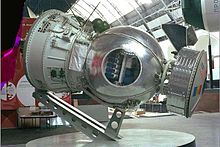- Bion (satellite)
-
The Bion satellites or Bion space program (Russian: Бион), also named Biocosmos, were a series of Soviet (later CIS) biosatellites. They were part of the Cosmos satellites.
The Soviet biosatellite program began in 1966 with Cosmos 110, and resumed in 1973 with Cosmos 605. Cooperation in space ventures between the U.S.S.R. and the U.S. was initiated in 1971, with the signing of the U.S./U.S.S.R. Science and Applications Agreement (which included an agreement on space research cooperation). The U.S.S.R. first offered to fly U.S. experiments on a Cosmos biosatellite in 1974, only a few years after the termination (in 1969) of the U.S. biosatellite program. The offer was realized in 1975 when the first joint U.S./U.S.S.R. investigations were carried out on the Cosmos 782 mission.
The Bion spacecraft were based on the Zenit reconnaissance satellite and launches began in 1973 with primary emphasis on the problems of radiation effects on human beings. Launches in the program included Cosmos 110, 605, 670, 782, plus Nauka modules flown on Zenit-2M reconnaissance satellites. 90kg of equipment could be contained in the external Nauka module.
The Soviet/Russian Bion program provided U.S. investigators a platform for launching Fundamental Space Biology and biomedical experiments into space. The Bion program, which began in 1966, included a series of missions that flew biological experiments using primates, rodents, insects, cells, and plants on an unmanned biosatellite in near-earth orbit. NASA became involved in the program in 1975 and participated in 9 of the 11 Bion missions. NASA ended its participation in the program with the Bion 11 mission launched in December 1996. The collaboration has resulted in the flight of more than 100 U.S. experiments, one-half of all U.S. Life Sciences flight experiments accomplished with non-human subjects.[1]
The missions ranged from five days (Bion 6) to around 22 days (Bion 1 and Cosmos 110).[2]
Bion spacecraft:
- Cosmos 110, 1966
- Bion 1, Cosmos 605, 1973
- Bion 2, Cosmos 690, 1974
- Bion 3, Cosmos 782, 1975
- Bion 4, Cosmos 936, 1977
- Bion 5, Cosmos 1129, 1979
- Bion 6, Cosmos 1514, 1983
- Bion 7, Cosmos 1667, 1985
- Bion 8, Cosmos 1887, 1987
- Bion 9, Cosmos 2044, 1989
- Bion 10, Cosmos 2229, 1992
- Bion 11, 1996.
See also
External links
- Zenit Satellites - Bion Variant
- Astronautix, Bion
- TsSKB, Bion images (Russian)
- RW Ballard, and JP Connolly. U.S./U.S.S.R. joint research in space biology and medicine on Cosmos biosatellites. FASEB J. 4: 5-9.[3] (Overview of Bion 1 to 9)
Bion satellites (Kosmos number in brackets)Categories:- Bion satellites
- Russian Earth satellites
- Artificial satellites formerly orbiting Earth
- Soviet Earth satellites
Wikimedia Foundation. 2010.


